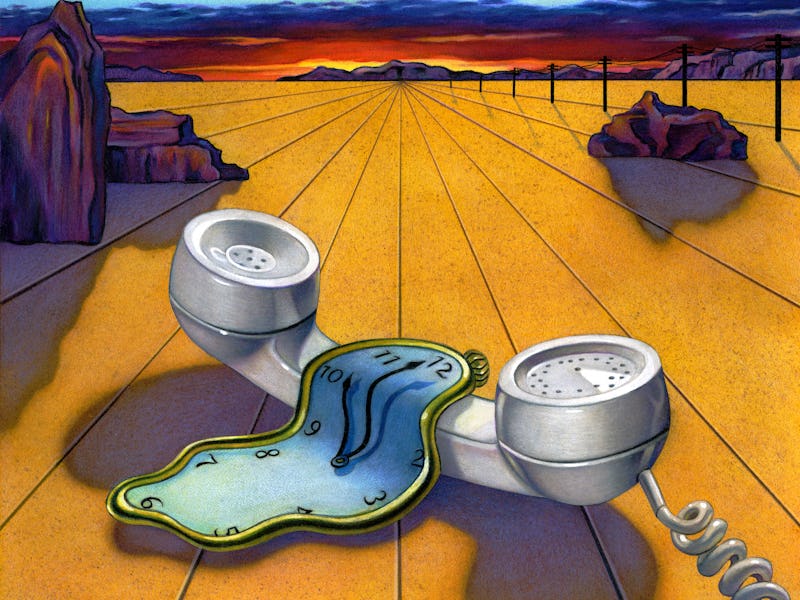Physicists are rethinking how we measure time
Time is all a matter of atoms.

Whether you sport a smartwatch or a Rolex, you likely believe the time your watch of choice tells you. We’re here to break it to you though: These timepieces are grossly inaccurate compared to the most accurate clocks in the world. But there is no such thing as perfect, it seems — because this year scientists made the most accurate clocks even more accurate.
INVERSE is counting down the 20 science discoveries that made us say “WTF” in 2021. This is #5. See the full list here.
What is an atomic clock?
Atoms exist at different frequencies. If you recall high school science classes, you might recall putting magnesium in a flame and it then emitting a very bright light — this is essentially a frequency. Atomic clocks use these frequencies — specifically, absorbing and emitting photons at regular intervals to keep time. They are the most accurate clock we have to measure time in seconds.
A common kind of atomic clock uses a form of cesium called cesium-133. In this case, microwave energy interacts with atoms belonging to a form of cesium called cesium-133. The cesium-133 oscillates between two states and emits a pulse, over and over.
Since 1967, the formal definition of a second has been:
“The duration of 9,192,631,770 periods of the radiation corresponding to the transition between the two hyperfine levels of the ground state of the cesium-133 atom.”
In other words, in a single second, a cesium-133 atom transitions some 9,192,631,770 times. There is a tiny degree of inaccuracy here, however: There are minuscule differences in the time kept by the atoms, and attempts to quantify these differences had an accuracy of up to 17 digits. Such knowledge matters — if you are able to better account for the errors, then you can more accurately gauge the exact period of a second using an atomic clock. In other words, increasing the degree of accuracy here may mean redefining the second itself.
What’s new — In a study earlier this year, researchers laid the groundwork to do exactly that: A research team based in Colorado decided to try to improve on atomic clocks’ design by testing whether transmitting data via a length of fiber-optic cable or via lasers.
They wanted to know:
- Could they use different elements to tell the time?
- And, how did the different data methods alter the tiny differences between the time kept by atoms?
- Could they improve the accuracy of this measure?
Together, the results suggest the new methodology could provide 18-digit accuracy to the measure of the difference between atoms. They published their findings in the journal Nature in March.
How they did it — The team devised three atomic clocks that used other elements:
- An aluminum-ion atomic clock
- A ytterbium atomic clock
- A strontium atomic clock
Charles H. Townes at Columbia University shows one of the first atomic clocks.
The aluminum-ion and ytterbium clocks were kept in a lab in Boulder, Colorado. The strontium clock was placed about a mile away in a different lab. Then, the researchers spent months sending data points back and forth between the clocks using a little more than two miles worth of fiber optic cabling or shooting data in the form of laser pulses across a free-space link between the labs (literally an optical light signal traveling freely across a distance).
They found the free-space link no different in terms of certainty than the fiber-optic cables. Ultimately, this is the most accurate measurement made to date of the ratios between these clocks — and offers a new foundation for innovating atomic clocks as a whole.
Why it matters — Back in March, we talked to Rachel Godun, a senior research scientist in the Time and Frequency group at the National Physical Laboratory in the U.K. She told Inverse the use of free-space links to connect clocks could prove a game-changer for people far beyond the study of physics:
“The authors’ demonstration that high accuracy clocks can be connected by free-space links, without needing an optical-fiber infrastructure, is exciting because it opens up possibilities for applications outside the laboratory, such as land surveying.”
The researchers’ work could also, one day, entirely redefine what we think “a second” actually means.
What’s next — Atomic clocks are incredibly accurate, but the technology they use is also old by today’s standards. The point of this study wasn’t so much to pick out a new and improved atomic clock, but rather further refine how these elements’ time-keeping accuracy was compared.
Once those standards are in place, it opens the door to new clocks and more innovation — and a new definition of the second.
If we manage that, then it could help physicists further test fundamental theories of the universe, like relativity and dark matter, by clocking atomic movements with greater precision.
INVERSE is counting down the 20 science discoveries that made us say “WTF” in 2021. This is #5. Read the original story here.
This article was originally published on